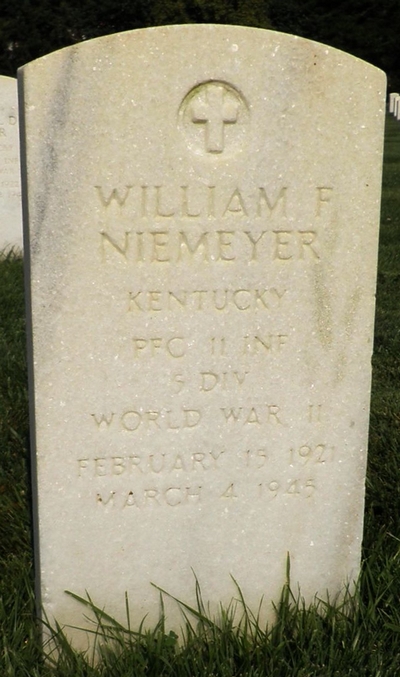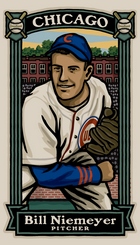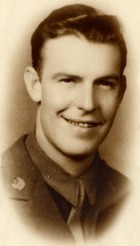Bill Niemeyer
| Date and Place of Birth: | February 13, 1921 Crescent Springs, KY |
| Date and Place of Death: | March 4, 1945 near Erdorf, Germany |
| Baseball Experience: | Minor League |
| Position: | Pitcher |
| Rank: | Private First-Class |
| Military Unit: | Company G, 11th Infantry Regiment, 5th Infantry Division |
| Area Served: | European Theater of Operations |
Bill Niemeyer was learning to be a professional pitcher and working his way towards the minor leagues. But his career, and his life, were ended on a battlefield in Europe within months of joining the Army.
William F. Niemeyer was born in Crescent Springs, Kentucky, about six
miles southwest of Cincinnati. His parents, Willie and Johanna Niemeyer,
were of German origin, and Willie was the district salesman for a feed
company. His parents were quiet people, hard working and strict
Catholics. As a result, their son was of a quiet nature and perhaps a
little shy, but also a naturally gifted athlete.
Niemeyer attended St. Joseph's Elementary School in Crescent Springs and
St. Henry High School in Erlanger, Kentucky, where his athletic talents
were soon noticed. Upon graduation, he signed a professional contract
with the Erwin Mountaineers of the Class D Appalachian League. The
6-foot-2-inch right-hander made 31 appearances for the basement-dwelling
Mountaineers, and despite a 7-17 won-loss record he led the team's
pitching staff in victories and innings pitched (205).
He advanced to the Harrisonburg Turks of the Class C Virginia League in
1941, but after a 0-2 record in 12 appearances and an inflated 6.70 ERA,
the 20-year-old was returned to the Appalachian League in June, joining
the Kingsport Cherokees. He was on the move again later in the season,
joining the Johnson City Cardinals of the same league, and while there,
he met and later married Marie Saltz. "Marie was beautiful and so
sweet," recalled Niemeyer's first cousin Betty Stevens-Marcum. "She had
naturally curly brown hair, green eyes and a lovely complexion. I was
just a little kid, but she treated me with deep respect."
In 1942, Niemeyer was again pitching in the Appalachian League, this
time with the Greeneville Burley Cubs, and made just six appearances for
an 0-4 record. He was out of organized baseball in 1943, but made a
brief return in 1944, with the Erwin Cubs of the Appalachian League. By
this time, however, the United States was deep in the horrors of a world
war, and every able-bodied man was needed for military service. In
August 1944, he left his young wife, Marie, and their daughters, Deanna
Gail and Mary Johanna, to serve with the Army.
Niemeyer was sent overseas to Europe in January 1945, and became a
replacement with Company G, 2nd Battalion, 11th Infantry Regiment of the
5th "Red Diamond" Infantry Division. The division had just helped to
secure the southern flank of the Bulge in Luxembourg and was now driving
eastwards through Germany. Having cracked the Siegfried Line, and
captured the town of Bitburg, the next objective was to cross the Kyll
River which would represent the deepest Third Army penetration of
Germany. Enemy forces had withdrawn across the Kyll River to new
defensive positions amid a densely wooded area and blown the bridges in
their retreat. With the arrival of darkness on March 2, 1945, engineers
began the construction of footbridges across the river and at 11:25
P.M., Niemeyer and the 2nd Battalion began moving over the footbridge
amid sporadic mortar fire. The objective was the town of Erdorf and they
soon found themselves fighting against stiffening enemy resistance,
frequent artillery fire and counterattacks. By March 4, G and F
Companies were involved in clearing an area named Hill 378 and securing
a wooded area nearby when they were met with tank-supported resistance.
Private First Class Niemeyer was among the 34 casualties suffered during
the action that day.
Marie was at her home in Johnson City, Tennessee, when she received news
that her husband had been reported missing in action. It was Marie's
duty to pass the news on to Bill's parents in Crescent Springs, 300
miles away, but they did not have a telephone. "Marie called our house
with the bad news," explained his first cousin Betty Stevens-Marcum,
whose family also lived in Crescent Springs. "Only 12 years old, I was
chosen to walk the block to tell Bill's parents that he was missing." A
short time later, Betty had to perform the same duty with the news that
Bill had been confirmed as killed in action.
Niemeyer was originally buried at the American Military Cemetery at
Hamm, Luxembourg. His remains were returned to the United States in
1949, and he now rests at the Camp Nelson Military Cemetery at
Nicholasville, Kentucky. "I attended Billy's funeral," remembers Betty
Stevens-Marcum. "It was the first time I heard 'taps' played on the
trumpet ... chilling."
|
Year |
Team |
League |
Class |
G |
IP |
ER |
BB |
SO |
W |
L |
ERA |
| 1940 | Erwin | Appalachian | D | 31 | 205 | 134 | 124 | 64 | 7 | 17 | 5.88 |
| 1941 | Harrisonburg | Virginia | C | 12 | 43 | 32 | 13 | 13 | 0 | 2 | 6.70 |
| 1941 | Kingsport/Johnson City/Greeneville | Appalachian | D | 7 | 40 | - | 12 | 14 | 1 | 3 | - |
| 1942 | Greeneville | Appalachian | D | 6 | 30 | - | 15 | 20 | 0 | 4 | - |
| 1943 | Did Not Play | ||||||||||
| 1944 | Erwin | Appalachian | D | 1 | 1 | - | - | 0 | 0 | 0 | - |

Bill Niemeyer's grave at Camp Nelson Military Cemetery at Nicholasville, Kentucky
 |
 |
| This baseball card of Bill Niemeyer was created by Gary Cieradkowski as part of the Infinite Baseball Card Set. It is available for purchase at a cost of $5.00. | |
Thanks to Phyllis Niemeyer and her family for help with this
biography and the photo of Bill Niemeyer, and Betty Stevens-Marcum and
her daughter, Dixie Roebker, for their help and insight into Bill
Niemeyer's life.
Date Added February 4, 2012. Updated June 6, 2014
Baseball's Greatest Sacrifice is associated with Baseball Almanac
Baseball's Greatest Sacrifice is proud to be sponsored by


